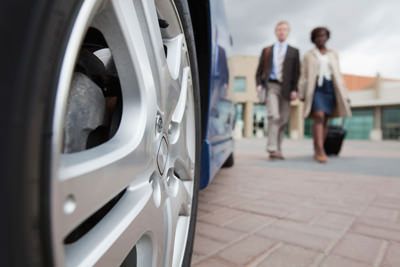Your car’s shock absorbers do more than contribute to a smooth ride. In fact, their primary purpose is to help you maintain control of your vehicle. Replacing worn or bad shocks can improve handling and control, reduce premature tire wear, and shorten stopping distance. Learn how to determine if your shocks are in need of some help, and remember the symptoms of worn or failing shocks by asking yourself, "Is my car showing signs of being C.U.R.S.E.D.?"
C - Car veering or sliding in side winds? Unless you’re driving through a tornado (which we don’t advise), this could mean you’re dealing with a shock absorber problem. Worn or leaking shocks can lead to unsteadiness on the road. You shouldn't have to “correct” your car, even in mild gusts.
U - Uneven wear appearing on your tires. Big red flag! When your shocks are worn, they can’t keep your tires firmly on the road, commonly resulting in cupping in your tires. To perform as the manufacturer intended, tires must maintain uniform contact with the road. However, worn shocks can contribute to premature and uneven tire wear, meaning you'll need to replace your tires much sooner. Additionally, uneven tires can increase your risk of hydroplaning and leave you more prone to a sudden flat.
R - Rocking, rolling and rattling. Hold tight! Is that a mini-earthquake? It could point to worn shocks when your vehicle shakes, rattles, and rocks a little too hard when driving over minor road bumps or railroad tracks. Since a car's shocks are responsible for controlling the impact and vibration of a vehicle's springs and suspension, worn ones won't be able to soften the blows of the road. A rattlin' ride is not only uncomfortable—it can put undue pressure on other parts of the car and could soon lead to more than shock troubles.
S - Swerving and dipping when applying your brakes. If bringing your car to a stop causes the front end to dip noticeably or, worse yet, results in any swerving, worn shocks may be the culprit. Watch out, since this symptom could prove especially dangerous in wet weather.
E - Excessive vibration in your steering wheel. Traveling over an uneven road surface can naturally cause the steering wheel to vibrate a little, but the vibration should go away as soon as you reach a smoother surface. If the vibration remains constant while you're driving, it might be a sign that there's a serious problem with your shocks. At highway speeds, these vibrations could become more intense and hamper your ability to control the car.
D - Delayed or longer stopping distances. Worn shock absorbers can increase your braking distance by 20 percent, writes the Daily Monitor, which could mean the difference between a safe stop and an accident. This symptom may have you coming in for a brake inspection, which is A-OK. Our experienced technicians will be able to diagnose the real culprit, whether it's low brake fluid, worn shocks, or something else entirely.
Wait. So how can I test my shocks? Here's one way, but not the only way to do it. With your car parked, press down on the front end of the vehicle and release. If more than a couple bounces are required to calm the car, the shocks might be worn. You can repeat this test with the rear of the vehicle, too.
These worn shock symptoms won't appear overnight. Shocks wear out over time, making it difficult to determine when they need to be replaced. Think of your car's shocks like a pair of tennis shoes. Since it takes your shoes such a long time to wear down, you may not remember how they originally performed and supported your feet until you get new shoes!
If you notice one of these signs, spring into action for your own safety and start with a complete vehicle inspection at your nearest Firestone Complete Auto Care. During an inspection, technicians will check for any suspension-related issues, including damaged shocks or struts, broken mounts or bushings, and vehicle swaying or bouncing. After diagnosing the problem, they’ll advise you on next steps to get rid of any “C.U.R.S.E.D.” symptoms of bad shocks!



